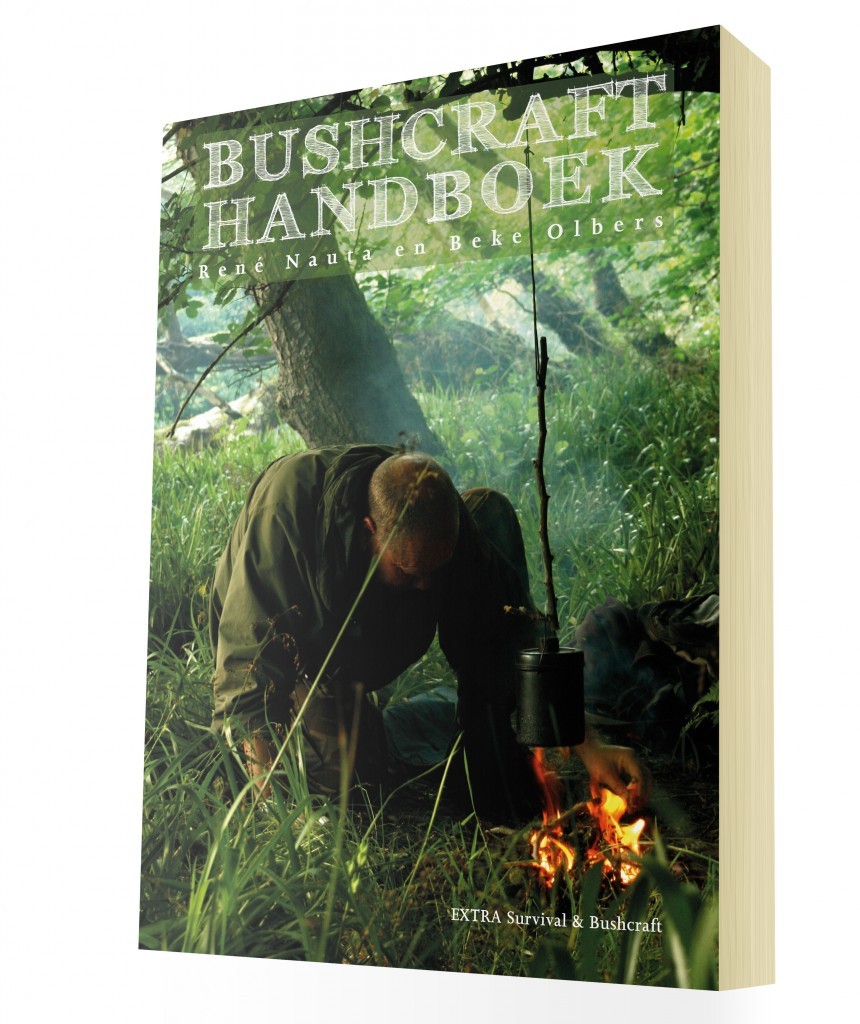BOOK REVIEW
Finally there is a book about bushcraft in Dutch. Before, aspiring bushcrafters mainly had to resort to English books like Ray Mears’ excellent Essential Bushcraft, Mors Kochanski’s classic Bushcraft, or look online for -again- mainly English content. But no more.

29 Nov. 2015 the Bushcraft Handboek (€ 29,95) was presented by René Nauta and Beke Olbers of EXTRA Survival in Drenthe (The Netherlands). This self-published work contains the fruits of almost two decades of practicing and teaching bushcraft and survival. And the writers didn’t take half measures. The book has almost 300 pages filled with useful info on the usual survival subjects like fire, shelter, water and food and it also has chapters on the practical application of plants and mushrooms, animal tracking and tips for when on the move in nature. Many excellent photographs and sketch drawings by Nauta supplement the clear text.
Bushcraft vs Survival
René Nauta started his Dutch bushcraft and survival school in 1997, even before the term “bushcraft” was well known. The difference between bushcraft and survival is a subtle one and mainly has to do with the situation that the practitioner is in. A typical survival situation is somebody lost in the wilderness, trying to stay alive and find their way back to civilisation. Bushcraft on the other hand, is all about voluntarily spending time in nature because you enjoy it and trying to make your stay as comfortable as possible. Although the similarities in the skills involved are much greater than the differences, Nauta added the word EXTRA to the name of his survival school to indicate that his courses included more than just plainly learning how to survive.
EXTRA was one of the first survival schools in The Netherlands. In 2009 Beke Olbers joined Nauta as his partner and by now the school has grown into the leading Dutch bushcraft company. It includes 8 assistant instructors and gives bushcraft and survival courses year round in The Netherlands and abroad. I took a number of courses with EXTRA Survival myself, including the 2003 Over-Leven-course in Northern England (3 days no food!) and learned many outdoor skills from them and the harsh reality of survival.
Field-tested techniques
It’s reassuring to know that many of the techniques described in the Bushcraft Handboek are tested by the writers and their students for over almost 20 years. And some of the techniques are described in great detail like how to make fire with the bow drill (9 pages), including possible problems and solutions you might encounter when learning this. Nauta and Olbers rightly emphasise however that a book will only take you so far and you will learn most by doing, which means going outside and getting your hands dirty.
Most topics are described in sufficient depth, but I did feel some subjects deserved more attention. For example, in the chapter about being on the move, there was very little information on navigation. In my experience, being able to figure out where you are and where to go is a critical skill in the wilderness, so more info on the use of map and compass would have been valuable. (Remember: many survival situations actually start by getting lost in some way). There was also no mention of lightweight backpacking gear and techniques, while on trekkings, the weight of the things you bring along has a huge impact on the distance you are able travel and your comfort while on the move. And finally, even though this is more a bushcraft than a survival book, I thought the descriptions of the emergency signals (including the signal fire), and the long log fire, was a bit to brief considering their importance for survival.
Besides these minor issues, I think the book is a great introduction to bushcraft and I’m impressed with the amount of work that Nauta and Olbers must have put in to create it. Who is this book ultimately for? I would say readers interested in bushcraft and survival in the temperate forests of Europe and who prefer to read in Dutch over English. For them this handbook contains great information on how to start feeling at home in nature.
Hopefully a digital version of the book will follow soon, making it even easier to bring it along on an outdoor trip 🙂

Great review. ..one for underground the xmas tree